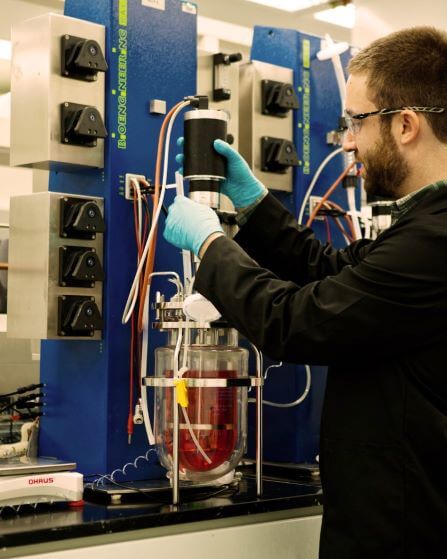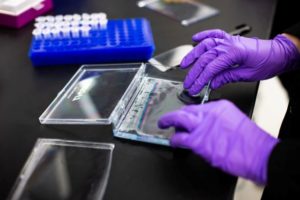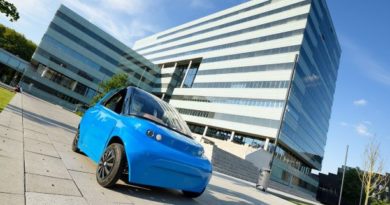Modern Meadow and the science of making leather without animal skin
 Fermenting Leather in a Lab
Fermenting Leather in a Lab
Modern Meadow, the New Jersey -based company is an upcoming pioneer in biofabricated materials, especially Leather.
“While Modern Meadow began as a small lab using tissue engineering to produce leather materials, we’ve evolved into a full-fledged biofabrication platform capable of producing a range of materials from animal-free collagen” says CEO Andras Forgacs of the Modern Meadows.
Modern Meadow’s technology platform uses the latest DNA editing tools to engineer specialised collagen-producing yeast cells. The cells are optimised to manufacture the type and quantity of collagen required. Once purified, the collagen is formulated and assembled into materials for consumer applications. “We’ve advanced our technology to the point where we are creating materials tailored to specific applications. With this announcement, we’re excited to bring bio-fabrication to consumers at scale,”Andras Forgacs added further.

Taking fashion and daily object’s use of leather as quintessential material for our day to day lives, Modern Meadow’s Bio-fabricated leather is both cruelty free and environmentally sound. Its patented material called Zoa, may be the answer to environmentalists’ concerns regarding unnecessary killing of exotic animals for their hide or fur. Zoa is the result of their combined efforts and it is the company’s first generation of materials created with nature’s essential protein, collagen, without the use of any animal derivatives.
Earlier in June, World economic Forum, Selected Modern Meadow as a Technology Pioneer. They have an over 70 people team with expertise in molecular biology, material science, engineering and design. Modern Meadow currently have the support of world class investors such as Horizons Ventures, Iconiq Capital, ARTIS Ventures, Temasek, Breakout Ventures and Tony Fadell.
The biofabrication process involves growing living collagen cells, which are found in animal skins, which can then be assembled into materials with customised structural and aesthetic properties. These qualities are defined by editing DNA molecules to produce distinct characteristics in the collagen as it is grown into a network of fibres.

This bioleather – created to match the distinct needs of customers – can then be tanned and finished to create raw material for brands to use in finished goods. Modern Meadow is already partnering with luxury and consumer goods brands to create products made from Zoa.
Its partnership with chemicals specialist Evonik, an expert in microbial fermentation is vital to Modern Meadow’s ambition to mass produce Zoa. There is also a possibility that the partnership will lead to further collaboration in the development of other proteins.
The big brands too see that animal derivatives like hide, fur and leather are not attracting the millennials and gen Z, who often identify with politically active brands that speak up on social media, equate these animal derivatives as the animal cruelty.
In 2017, Gucci CEO Marco Bizzarri said that the company was interested in more modern materials, explaining that with “technology now available, you don’t need to use fur. The alternatives are luxurious. There is just no need.” Burberry noted in its announcement that going fur-free was part of the company’s quest towards a more sustainable footprint, with the ultimate goal of being carbon neutral.
The list is growing as John Galliano pledged to stop using fur at Maison Margiela, and Gucci, Michael Kors, and Jimmy Choo (which is owned by Michael Kors) all plan to phase out their use of fur by the end of 2018.
According to one estimate the leather industry is about $200 billion dollars worth and more than a billion animals lose their lives for their skin and hides every year. Modern meadow’s biofabricated leather can reduce these numbers and its effect on the environment. The demand for leather is not going away from the world and relies on the livestock industry which has a very large carbon footprint as it is the biggest contributor of green house gas emissions. Compared to traditional leather, biofabricated leather takes a fraction of time to produce. it takes roughly a week to grow the protein and that step is crucial, to step up from protein to material also takes another week, so the process takes 15 days to come up with the raw material. the degree of usage ranges from furniture, to car seats, where traditional leather is used.
Biofabrication is already a key area of research across many industries. In the development of pharmaceuticals, chemicals, consumer products, cosmetic and agricultural products, for example, extensive testing is often required to ensure that they are safe for the environment and for consumers. Due to this testing on animals, problems can arise.
There is no doubting the ingenuity that has led to the creation of the world’s first bioleather material, and it is clear that biofabrication in all its forms will play a central role in the development of many industries in the years ahead. However there are still doubts over consumer preferences and reaction of the leather industry, but there is never a bad time to look ahead and embrace what comes next. Biofabricated alternatives to animal hides are here to stay, and a partnership between the established industry players and the innovators could hold great promise for the future.




